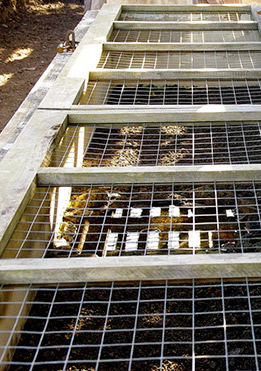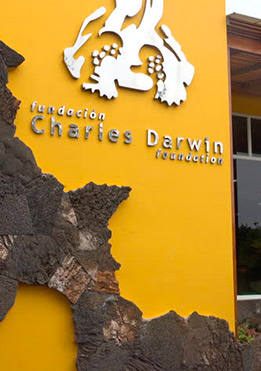
The Charles Darwin Research Station is located towards the northeastern part of Puerto Ayora. It has all the trappings of a national park and up to 200 volunteers. Also, scientists congregate here with each one of them being involved in conservation and research efforts. The breeding program here is unique and has been productive since inception.
 The Charles Darwin Research Station was founded in 1964, and many research projects have been carried out here since then. Additionally, a lot of conservatory and monitory activities get executed here on terrestrial and marine species inhabiting the islands and its water environment. Consequently, the endangered species of the islands is well protected. Two essential trees well protected by the activities ongoing at the Charles Darwin Research Station are the Floreana Plax and tree daisy, both of which would have gone into extinction if the research station had not been established. After propagating these plants and animal species at the research station, they are then returned to their origin on the Galapagos Islands, where they are allowed to regenerate. Follow this link if you want to know more about the origin of the Charles Darwin Research Station
The Charles Darwin Research Station was founded in 1964, and many research projects have been carried out here since then. Additionally, a lot of conservatory and monitory activities get executed here on terrestrial and marine species inhabiting the islands and its water environment. Consequently, the endangered species of the islands is well protected. Two essential trees well protected by the activities ongoing at the Charles Darwin Research Station are the Floreana Plax and tree daisy, both of which would have gone into extinction if the research station had not been established. After propagating these plants and animal species at the research station, they are then returned to their origin on the Galapagos Islands, where they are allowed to regenerate. Follow this link if you want to know more about the origin of the Charles Darwin Research Station
 A summary of the goals of the Charles Darwin Research Station includes:
A summary of the goals of the Charles Darwin Research Station includes:
Recently, was discovered a hammered shark natural nursery, which is an effort of this station and other institutions
It’s time to travel to
Galapagos and Ecuador
Do you have some question? we are here to help you
The Galapagos tortoise is one of the major sights to see on this island. The arid-zone vegetation leads to the enclosure for the tortoise. There is rarely any other of the same size anywhere on the globe. The tortoise weighs 500 pounds, and it is as long as six feet. The various stages of growth of this tortoise are displayed in pictures right from the un-hatched egg stage to the full adult stage. It takes some eight months for the egg of the tortoise to hatch; at times, it can be reduced to four months. After hatching, the baby tortoise looks vulnerable and small, its weight not being more than 50 pounds, while its length is about six centimeter. Visiting this place can give you an opportunity to learn about the various stages of care and development of the tortoise, like incubation, hatching and growth stages.
Up to 11 species of tortoise are residing in the Charles Darwin Research Station. You will also find many land iguanas here. The incubator is placed in the specially-erected baby-tortoise house, and the number of the tortoise declined in the later part of the 1970s due to the activities of colonists and pirates. Consequently, the Galapagos tortoises are well protected to prevent a further decrease in number and possible extinction. The hatcheries are developed in such a way that the tortoises can develop without any threat from predators. They are later released to the island once they have adequately developed at the hatchery.
The first tortoise was taken from the Pinta Island to the Charles Darwin Research Station in 1971. Its name was Lonesome George, and it was the last surviving tortoise of the islands. All efforts to repopulate the tortoise failed, and it died in 2012, childless.
Aside from protecting endangered species, the activities at the Charles Darwin Research Station also include the provision of various educational programs in scientific research. Many scholars and researchers are welcome from across the globe to participate in these educational programs. The educational programs equally create awareness for the visitors to these islands, focusing on the urgency and importance of preserving the plant and animal species on the planet.
Bear in mind that the Galapagos Islands was named a natural heritage in 1978. The education centers of Charles Darwin Research Station are built in San Cristobal, Isabella, and Santa Cruz.
A visitor to the Charles Darwin Research Station can learn a lot about the island at Puerto Ayora where educational and enlightening services are provided to give the visitors adequate knowledge about this island, its conservations, birdlife, wildlife and more. Showrooms are built here to make the education process very easy for the tutors and “Students” alike. At the showrooms, the visitor can learn about all the species of plants and animals to be found on this island. Also, the visitor can learn about the conservation methods being adopted to protect and propagate the species towards avoiding their extinction.
The educative programs being offered here are presented in two languages; that is, English and Spanish. Many land birds can also be found in all their beauties on this island. Examples of the birds available here are the Darwin’s finches
It has been discovered over time that the works of the Charles Darwin Foundation being carried out at Galapagos Islands are essential for the protection and conservation of the plant and animal species on these islands. The activities of the research station have scientific significance, as well as educational benefits. It also confers an extended level of protection on the environment. The research activities going on here are supported by Galapagos Conservancy.
If you want to vist these unique islands, we invite you to read our Galapagos Cruise page.
Leave a Comment